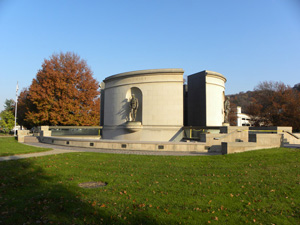

Remember...
James Done Kerns
1893-1918
"No commander was ever privileged to lead a finer force; no commander ever derived greater inspiration from the performance of his troops."
John J. Pershing
 |
Remember...James Done Kerns
|
James Done Kerns (known familiarly throughout his life as "Done":which was actually the name under which he registered for the draft) was born on April 26, 1893, in Job, Randolph County, West Virginia, the son of James and Angemima Nood Bonner Kerns. He had five sisters: Peachie May, Texie, Carrie, Rebecca, and Mary E. Kerns. There were also three brothers: Eli, John Albert, and Sully Sanford Kerns. Eli, John Albert, and Rebecca had died before reaching adulthood.
Private Done Kerns was assigned to Company A, U.S. Army Reserve 80th Division (the Blue Ridge Mountain Division), 320th Infantry. This division, which consisted of men mostly from Pennsylvania, Virginia, and West Virginia, trained at Camp Lee in Petersburg, Virginia, prior to embarking for duty overseas. The 80th:23,000 strong:landed in France on June 8, 1918, and began training with the British Third Army. Under the command of General John J. Pershing, the First Army, consisting of several divisions including the 80th Division, commenced the Battle of St. Mihiel on September 12, 1918. This was the first major independent American offensive of the war. During this battle American forces suffered 7,000 casualties. By September 13 victory had been achieved, and General Pershing began withdrawing American forces in preparation for the coming Meuse-Argonne offensive.
On September 26, 1918, the Meuse-Argonne offensive was begun by the Allied Expeditionary Forces in what was to become the greatest American battle of World War I. During the six weeks' confrontation, 27,277 were killed and 95,786 were wounded. The objective of this campaign was to repel the Germans eastward from the Hindenburg Line to deny them access to important rail lines which were supplying the German front. Thirty-seven French and U.S. divisions were opposed by 24 German divisions. By early October the German Army was exhausted, demoralized, and plagued with an influenza outbreak. On October 9 during a battle with the Germans on the east bank of the Meuse River, Done Kerns was killed. Another month of fighting resulted in victory by the Allies and an armistice on November 11, bringing the war to a close.
Article prepared by Leon Armentrout

West Virginia Archives and History welcomes any additional information that can be provided about these veterans, including photographs, family names, letters and other relevant personal history.